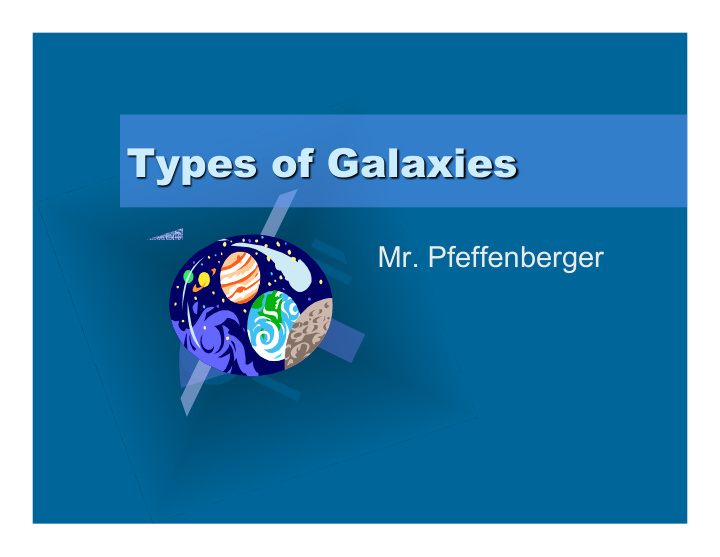



Types of Galaxies “ ” Mr. Pfeffenberger Add Corporate Logo “ ” Here
Elliptical Galaxies Most common type of galaxy – Shape – small/large , 3-dimensional ellipse or round – Smooth,featureless appearance and appear basically the same from any angle. – Made up of old stars and containing a small amount of gas, and dust. – Most are yellow and red because they do not contain young stars. – Vary in size from small to extremely large
Elliptical Facts • - do not have a disc or arms • - smooth, baseball or football shaped • - the smallest elliptical is called a “dwarf” elliptical and appears to be the most common type of galaxy • - the stars do not revolve around the center in an organized way. Their movement is randomly oriented
Elliptical Galaxy
Spiral Galaxies Spiral arms winding outward from inner regions – Loose, lumpy spiral arms (two or more) are made of bright blue young stars in the cstar and yellow stars throughout the disc, and dust. Most arms start close to the center of the galaxy; so it has a small central bulge. It is referred to as a pinwheel shape. – Made mainly of young stars and contains a large amount of gas.
Spiral galaxies II – Example - Andromeda so far away that you can ’ t see its individual stars. It appears as a hazy spot in our sky. – It is about 2.2 million light years away
Spiral Galaxy with 3 main components: bulge, disk and halo
Barred Spiral Galaxy • A pinwheel-shaped galaxy containing many new stars and a large amount of gas. • A “ bar ” of stars, dust and gas runs across its center
Light year • The distance that light travels in one year. • Light travels at 300,000 km/s, or about 9.5 trillion kilometers in one year. • The nearest star to earth other than the sun is Proxima Centauri. • It is 4.2 light years away, or about 40 trillion kilometers.
Irregular Galaxies – No definite structure – Smaller and less common than other galaxies – Tend to have a blue or white color because recent star formation makes galaxies appear blue. – Composed of both young and old stars, and it contains large amounts of gas and dust.
Irregular Galaxy
Milky Way – Contains more than 400 billion stars and may contain up to 1 trillion – The visible disc of stars Is about 100,000 light years across – The sun is located about 30,000 light years out from its center
Milky Way • The Sun orbits the center of the Milky Way once every 240 million years – Scientists do not know if it is a barred spiral galaxy or a normal spiral galaxy
Spiral Galaxy - Our Milky Way
Recommend
More recommend